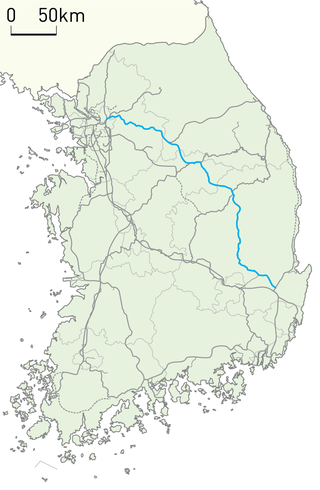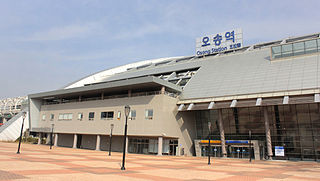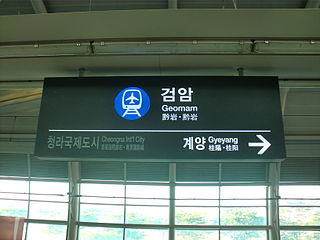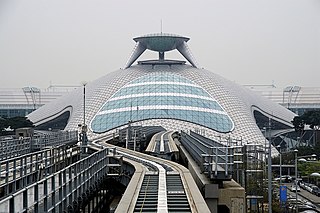
The Korea Railroad Corporation is the national railway operator in South Korea. It is branded as KORAIL (코레일) and changed its official Korean name in November 2019. Currently, KORAIL is a public corporation, managed by Ministry of Land, Infrastructure and Transportation.

The Gyeongbu line (Gyeongbuseon) is a railway line in South Korea and is considered to be the most important and one of the oldest in the country. It was constructed in 1905, connecting Seoul with Busan via Suwon, Daejeon, and Daegu. It is by far the most heavily travelled rail line in South Korea.

The Jungang line is a railway line connecting Cheongnyangni in Seoul to Moryang in Gyeongju in South Korea, traversing central South Korea from the northwest to the southeast. It is also referred to as the rail line of the Seoul Metropolitan Subway from Yongsan station to Jipyeong station. The section from Cheongnyangni to Dodam was designated as a semi-high-speed railway.

Korea Train eXpress (Korean: 한국고속철도), often known as KTX, is South Korea's high-speed rail system, operated by Korail. Construction began on the high-speed line from Seoul to Busan in 1992. KTX services were launched on April 1, 2004.

Seoul Station (Korean: 서울역) is a major railway station in Seoul, the capital of South Korea. The station is served by the Korail Intercity Lines and the commuter trains of the Seoul Metropolitan Subway.

The Gyeongjeon Line (Gyeongjeonseon) is a railway line serving South Gyeongsang and South Jeolla Provinces in South Korea. It covers a total of 300.6 km, from Samnangjin Station in Miryang, South Gyeongsang, to Gwangju Songjeong Station in Gwangju, South Jeolla.

Dongdaegu Station (Korean: 동대구역), meaning "East Daegu Station", is a railway station in Daegu, South Korea. It is on the national high-speed KTX railway network, 282 km (175 mi) south of Seoul Station.

The Mugunghwa-ho (Korean: 무궁화호) is a class of train operated by Korail, the main railway operator of South Korea. Mugunghwa trains are Korail's slowest tier of trains stopping at a number of towns and villages, and operating over a number of lines that are not served by other trains. Journey times are generally twice that of KTX trains and 25% longer than ITX express trains.

AREX is a South Korean airport rail link and commuter rail line that links Incheon International Airport with Seoul Station via Gimpo International Airport.

Gupo station is a Korail station on the Gyeongbu Line, between Hwamyeong station and Sasang station, located in northern Busan, South Korea. It was opened on 1 January 1905, and is connected with the subway Gupo station on Busan Metro Line 3 via an overhead bridge, so passengers can transfer.

The Gyeongbu high-speed railway, also known as Gyeongbu HSR, is South Korea's first high-speed rail line from Seoul to Busan. KTX high-speed trains operate three sections of the line: on 1 April 2004, the first between a junction near Geumcheon-gu Office station, Seoul and a junction at Daejeonjochajang station north of Daejeon, and a second between a junction at Okcheon station, southeast of Daejeon, and a junction near Jicheon station, north of Daegu entered service; then on 1 November 2010, the third section, between a junction west of Daegu and Busan became operational. The missing gaps across the urban areas of Daejeon and Daegu were in construction for an expected opening in 2014, separate tracks into Seoul Station were also planned. The temporary ends of the three sections were connected to the parallel conventional Gyeongbu Line by tracks that will serve as interconnector branches upon the completion of the entire line. On 1 August 2015, construction on urban areas of Daejeon and Daegu were completed; all the sections of HSR line were connected.

The Honam high-speed railway, also known as Honam HSR, is a high-speed rail between Osong and Mokpo in South Korea. The line is a part of Korail's Korea Train Express (KTX) system, accelerating Seoul–Mokpo and Seoul–Gwangju KTX high-speed services which currently use the existing conventional Honam Line. On April 1, 2015, the line was inaugurated by the South Korean President Park Geun-hye with the attendance of 1200 invited guests and members of the public at Gwangju Songjeong Station in Gwangju, the line's terminus. The line diverges from Osong station on the Gyeongbu high-speed railway, and stops at Gongju, Iksan, Jeongeup Stations. Journey times between Seoul and Gwangju has been cut from 2 h 40 min to just 90 min, making daily commuting possible. The Honam HSR is intended to bring business, and economic opportunities to the province of Jeollanam-do, which has seen slower development than other parts of South Korea. The line has been open to the public since April 2, 2015 for revenue service.

Osong station is a train station on the Honam and Gyeongbu high-speed railways in Cheongju City, North Chungcheong Province, South Korea. It is located at the intersection of the Gyeongbu KTX high-speed rail line, the conventional Chungbuk Line and, since April 2015, the Honam high-speed railway. KTX trains began calling there from November 1, 2010, bringing high-speed rail service to the nearby city of Cheongju.

Geomam station is a railway station on AREX and Incheon Subway Line 2. Since June 2014, the KTX train operates from Incheon International Airport to Busan or Mokpo. It has stopped operating KTX since March 2018. In September 2018, Korail officially announced that they would stop operating KTX to Incheon International Airport due to lack of passenger use. This was the first KTX station after Incheon Airport. Before KTX started to run on AREX, all platforms were high-leveled with screen doors. The KTX started to run, they took away the platform screen doors only at the both end of the side horizontally and turned into low-leveled platform without screen doors.

Incheon International Airport Terminal 1 station is a railway station on AREX and the Incheon Airport Maglev. It is in Incheon International Airport's transport center near Terminal 1.

The KTX-Sancheon is a South Korean high-speed train built by Hyundai Rotem in the second half of the 2000s and operated by Korail since March 2010. With a top speed of 305 km/h (189.5 mph), the KTX-Sancheon is the second commercial high-speed train operated in South Korea and the first domestic high-speed train that is designed and developed in South Korea.

The KTX-I, also known as the TGV-K or Korail Class 100000, is a South Korean high speed train class based on the French TGV Réseau. The 20-car formation of the trainsets without a restaurant car is optimized for high capacity. The 46 trainsets were built partly in France and partly in South Korea in the framework of a technology transfer agreement, which was the basis for further domestic high-speed train development in South Korea.

The Super Rapid Train, often known as SRT, is a high-speed rail service operated by SR Corporation. The service starts at Suseo station in southeast Seoul and terminates at either Busan station or Mokpo station.
High-speed rail service in South Korea began with the construction of a high-speed line from Seoul to Busan in 1992, and was inspired by Japan's Shinkansen. The first commercial high-speed rail service was launched on 1 April 2004. Currently, South Korea hosts two high-speed rail operators: Korea Train eXpress (KTX) and Super Rapid Train (SRT).
Seodaegu Station is a new railway station on the Gyeongbu high-speed railway newly established in Ihyeon-dong, Seo District, Daegu, South Korea. This station was opened on March 31, 2022.


















